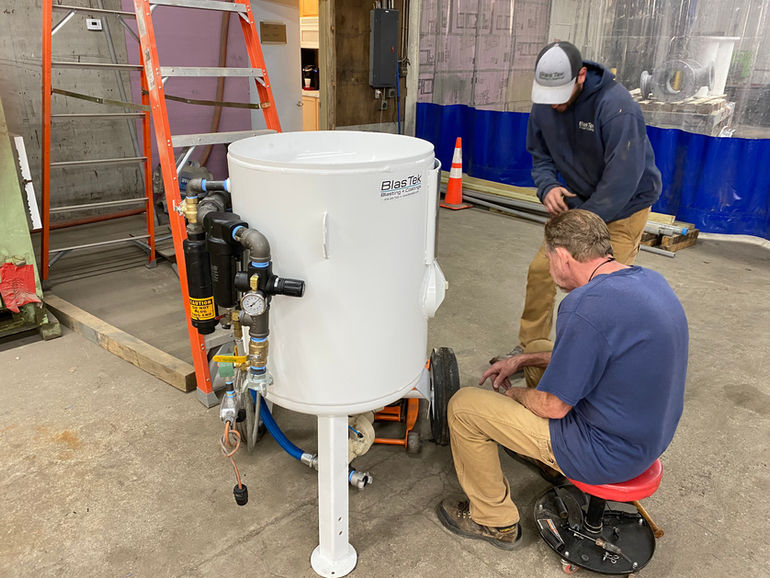
Mobile Blasting Services
Abrasive blasting is a critical step in the surface prep process, and we take pride in staying on top of the most current industry practices. That means we can tailor a surface prep solution specific to the requirements of our diverse customer base. Moreover, we have a team of dedicated and qualified individuals that do this every day, one that understands the ins and outs of blasting, and can continuously deliver results daily.
Our blasting systems are mobile trailer-based units that can be dispatched anywhere throughout the Mid West to support onsite and in-house cleaning requirements. We can also provide custom blast configurations to support specific project requirements.
Although our mobile blasting services are primarily used to support our industrial coatings work, we also provide mobile blasting services for specialized applications, such as lead paint abatement, industrial cleaning (see Dry Ice Blasting), fouling mitigation, mold removal, smoke/soot removal, and deployment of on-site blasting technologies to achieve cleanup and contract objectives.
Serving West Michigan and all the surrounding areas such as Ada, Allendale, Byron Center, Caledonia, Cascade, Cedar Springs, Comstock Park, Coopersville, Cutlerville, Dutton, Grand Rapids, Forest Hills, Grandville, Hudsonville, Jenison, Kentwood, Wyoming, Lowell, Middleville, Sparta, Spring Lake, Plainwell, Kalamazoo, Portage, Mattawan, Battle Creek, Ann Arbor, Lansing, Detroit, Saginaw, Flint, Mount Pleasant, Big Rapids. Ludington, South Haven, Saugatuck, Douglas, Holland, Grand Haven, Muskegon, and all of Muskegon County, Kent County, Ottawa County, Montcalm County, Allegan County, Barry County, Kalamazoo County, and Calhoun County.
Our onsite mobile blast services allow us to blast virtually any surface, including buildings, wood beams, structural steel, equipment, fabricated steel structures, storage containers, bridges, metal siding, decking, and many other commercial and industrial items.
Have questions about what blasting can and can't do? Contact us today and lets figure it out together.
Soda Blasting
Soda blasting is becoming increasingly popular as an alternative to sandblasting or other traditional forms of abrasive media blasting. The process uses baking soda (sodium bicarbonate) as the blast media (chemically equivalent to the stuff you would find in most fridges). Whereas the baking soda starts off as a salt-like granule, it shatters upon impact into thousands of smaller pieces. This force of kinetic energy is especially useful for cleaning delicate surfaces, and also restoring surfaces without causing harm to the substrate. Unlike sandblasting, soda blasting creates little-to-no friction, making it especially ideal for restoring and stripping thin metal pieces and other delicate cleaning applications. And because sodium bicarbonate is a rust inhibitor, soda blasting provides an added protection for corrosion prevention.
At BlasTek, we use soda blasting for a variety of applications. Perhaps the most popular application is smoke and soot removal. Soda blasting produces a much finer finish than, for example, sandblasting on wood objects, making it the ideal solution for clients looking for a more refined finish on their wood restoration projects. We also do a lot of surface prep work for clients that deal with soft and malleable metals, such as aluminum, and higher-grade metals such as stainless steel.
Abrasive Blasting
Media blasting is not a one-dimensional process. In fact, when you think about all the different types and sizes of abrasives available, there are endless profiles and finishes that can be achieved via abrasive blasting. From hard abrasives such as garnet and Black Beauty to soft agri-media such as corn cob grit and walnut shell, we have the equipment and technical know-how to properly utilize virtually every abrasive.
Perhaps the most common form of abrasive blasting is sandblasting. In line with BlasTek's safety standards, our blasting pots are solely filled with the silica-free sand substitute olivine. We are have the ability to remove rust, mill scale, old coatings, and contamination in preparation for a high-performance coating for a wide range of items including structural steel, I-beams, trusses, heavy equipment, fabricated steel structures, pressure vessels, bulk storage tanks, silos, bridges, freighters, and many other commercial and industrial items. Here are some examples of the types of metal we are capable of blasting: steel, iron, copper, brass, and aluminum.

Surface Prep Standards
-
SSPC-SP5 / NACE 1 White Metal Blast Cleaning: When viewed without magnification, the surface shall be free of all visible oil, grease, dust, dirt, mill scale, rust, coatings, oxides, corrosion products, and other foreign matter.
-
SSPC-SP10 / NACE 2 Near-White Blast Cleaning: When viewed without magnification shall be free of all visible oil, grease, dust, dirt, mill scale, rust, coating, oxides, corrosion products and other foreign matter of at least 95% of each unit area. Staining shall be limited to no more than 5 percent of each unit area and may consist of light shadows, slight streaks, or minor discolorations caused by stains of rust, stains of mill scale, or stains of previously applied coatings. The unit area shall be approximately 3 in. 3 in. (9 sq. in.)
-
SSPC-SP6 / NACE 3 Commercial Blast Cleaning: When viewed without magnification, the surface shall be free of all visible oil, grease, dust, dirt, mill scale, rust, coating, oxides, corrosion products and other foreign matter of at least 66-2/3% of unit area, which shall be a square 3 in. x 3 in. (9 sq. in.). Light shadows, slight streaks, or minor discolorations caused by stains of rust, stains of mill scale, or stains of previously applied coating in less than 33-1/3% of the unit area is acceptable.
-
SSPC-SP7 / NACE 4 Brush-Off Blast Cleaning: When viewed without magnification, the surface shall be free of all visible oil, grease, dirt, dust, loose mill scale, loose rust, and loose coating. Tightly adherent mill scale, rust, and coating may remain on the surface. Mill scale, rust, and coating are considered tightly adherent if they cannot be removed by lifting with a dull putty knife.


